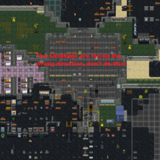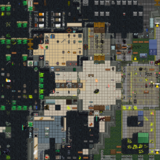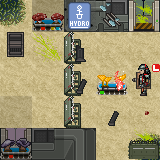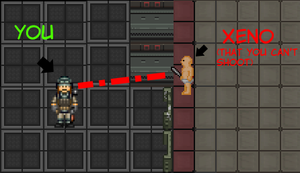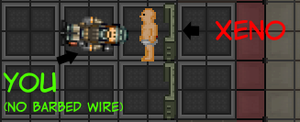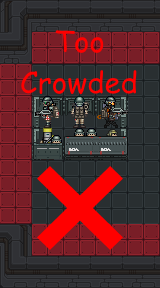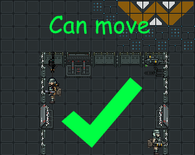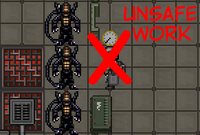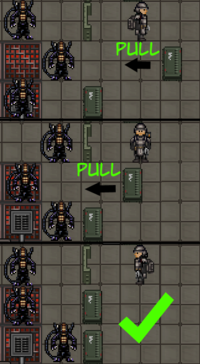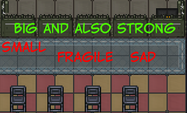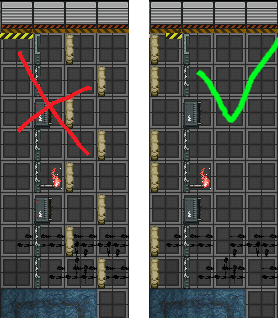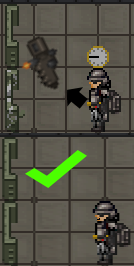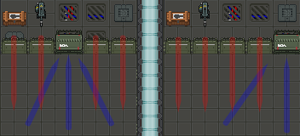More actions
mNo edit summary |
|||
| Line 159: | Line 159: | ||
|- | |- | ||
|style="border: 2px solid black; padding: 5px;"| [[File:Medmag-pouch.png|64px]]<br>'''Magazine Pouch''' | |style="border: 2px solid black; padding: 5px;"| [[File:Medmag-pouch.png|64px]]<br>'''Magazine Pouch''' | ||
|style="border: 2px solid black; padding: 5px;"| | |style="border: 2px solid black; padding: 5px;"|{{Magazine Pouch Description}} | ||
|- | |- | ||
|style="border: 2px solid black; padding: 5px;"| [[File:Medium-gen-pouch.png|64px]]<br>'''Medium General Pouch''' | |style="border: 2px solid black; padding: 5px;"| [[File:Medium-gen-pouch.png|64px]]<br>'''Medium General Pouch''' | ||
Revision as of 09:27, 6 September 2020
 |
Difficulty: Medium Supervisors: Squad Leader Rank: Lance Corporal Duties: Set up defenses, babysit big guns, open doors and spam barbed wire. Guides: Construction, Guide to Engineering Unlock Requirements: Three hours as any squad role. Detailed Description: You have the equipment and skill to build fortifications, reroute power lines, and bunker down. Your squaddies will look to you when it comes to construction in the field of battle. |__________| |
But the good news — we got four of these robot sentries with display and scanners intact. They really kick ass, I think they'll come in handy.
―Corporal Hicks, Aliens
As a Squad Engineer, your main goals will be fixing power, getting through doors, and setting up fortifications for a FOB (Forward Operating Base) that'll be used for defense and to secure a supply route. Without you, your platoon will have no power or a FOB which is critical for mission success.
Squad Engineer
You'll have two different playstyles you can experiment with. One, as a FOB building and Utility Engineer, who sets up defences and makes sure power is running. The second way to play Engineer is to be a Combat Engineer, breaching walls, hacking open doors, welding vents and repairing broken APC and lights as marines advance. Both are as good as the other, but too much of one is bad. Make sure there is a FOB that will be able to be defended, and if there is one, make sure marines will be able to make it from building to building effectively.
 Automated Closet
Automated Closet 
| Pouch: | Description: | ||
|---|---|---|---|
 Construction Pouch |
Designed to holster construction materials. | ||
 Explosive Pouch |
Container designed to hold up to three grenades or other explosives. | ||
 Tools Pouch |
Designed to hold all your different types of tools. | ||
 Electronics Pouch |
Designed to hold all your electronic needs as an engineer. Issued to Engineers, or found inside the ColMarTech automated armaments vendor in Requisitions.
Contains 6 slots. | ||
 Magazine Pouch |
Uncommon issue pouch that can hold three magazines and/or handfuls of shotgun shells. Issued to Medics and Engineers. It is also one of the pouch options of the ColMarTech Automated Closet and is found in the ColMarTech automated armaments vendor in Requisitions. Contains 3 slots. | ||
 Medium General Pouch |
A general purpose pouch used to carry more small items and also magazines. Contains 2 slots. | ||
 Flare Pouch |
Can hold 8 flares (including activated flare). Refillable with a M94 Flare Pack. | ||
 First Aid Pouch |
Standard issue field aid for all soldiers. Comes pre-loaded with basic medical supplies. Expended autoinjectors can be restocked at a NanoMed | ||
 Large Pistol Magazine Pouch |
Pouch able to hold pistol magazines. | ||
 Pistol Pouch |
A holster to carry pistols, typically a standard issue M4A3 handgun, or 88M4 Pistol. |
| Mask: | Description: |
|---|---|
| File:Gas mask.png Gas Mask |
A face-covering mask that can be connected to an air supply. It is currently purely cosmetic. |
 Automated Equipment Rack
Automated Equipment Rack 
Each Equipment Rack starts with 45 points for you to spend on additional items for your deployment. These are all listed below.
|
Equipment and Gear
Metal and Sandbags
At round start, there are 30 plasteel sheets and 50 metal sheets in your essential engineer kit. Plasteel is an expensive but very resistant material at your disposal. More can be purchased at your equipment closet or as supplies start trickling in through the ASRS, you maybe able to acquire more. Don't hoard loads of building supplies otherwise you might find fellow Squad Engineers unable to perform their jobs.
Linking Plasteel Barricades 
You can link plasteel barricades together with a crowbar. This is can used for making a gate for the tank. It requires at least 2 plasteel barricades facing the same direction and same state in order for it to work.
Your Gear
Get your gear from the Squad Engineer prep room. Most notable gear are:
 Welding Goggles are used to avoid eye damage when welding. Remember to flip them down before you start.
Welding Goggles are used to avoid eye damage when welding. Remember to flip them down before you start. Webbings is spawned with your jumpsuit to allow you the quality of storage. Holds 3 normal size items.
Webbings is spawned with your jumpsuit to allow you the quality of storage. Holds 3 normal size items. The gloves in your locker are insulated gloves. If you lose them, get another pair from the vendor.
The gloves in your locker are insulated gloves. If you lose them, get another pair from the vendor.- For backpacks, you can choose from these two out of the vendor:
 Toolbelt, see the table below for details:
Toolbelt, see the table below for details:
| Item: | Function |
|---|---|
Screwdriver |
Used for securing and unsecuring sentries, also used to open maintenance panels for hacking. |
Blowtorch |
Used for cutting through walls and fixing sentries. Has 20 units of fuel inside. Refillable with fuel tank, welder pack or welding tank (turn off before refilling). |
Crowbar |
Used for Opening unpowered doors and displacing girders so you can move them. |
Wrench |
Used for securing most objects to the ground including girders,vendors, also has another use to rotate sentries. Easily the most used tool in your arsenal. |
Cable coil |
Used for fixing robotics and diverting power to other areas. |
Security Access Tuner |
Used to hack doors/ vendors along with disabling mines. |
Wirecutter |
Used for cutting cable coil and barbed wire, and mending it. |
In the field
Power and T-Comms
Upon the first deployment, you are likely to be tasked to either fixing the Power, building the Portable Telecommunications Tower or FOB duty.
Overcoming obstacles
 Use a crowbar to pry open powered down doors.
Use a crowbar to pry open powered down doors.- Hack doors to open previously locked passageways.
 C4 doors/walls if you don't have time to hack/deconstruct.
C4 doors/walls if you don't have time to hack/deconstruct.
Lighting up the place
Fix the APC's and replace broken lights with the light replacer along the way as you advance.
Floodlight Repair
While you may have fixed the power for the colony (and turned on the Colony Floodlight Switch ![]() ), the aliens will have most likely broken floodlights around the place which you'll need to fix. To fix a floodlight you'll want to use the following steps:
), the aliens will have most likely broken floodlights around the place which you'll need to fix. To fix a floodlight you'll want to use the following steps:
- Emergency Floodlights can be unwrenched and be moved around.
 Deploying your defensive structure
Deploying your defensive structure 
When you hit the field, you'll be needing to place your defensive structure down in order to have it either man the flanks or aid the marines in combat.
Simply take the defensive structure in your hand and click on it while it's in your active hand. Make sure the tile in front of you is empty and clear. Once deployed, make sure you click on the defensive structure again to turn it on. You can easily pick it up with a Security Access Tuner ![]() as long as it is in pristine condition. If it has been damaged, simply use a welder to repair it. You can also unanchor it to move it around without needing to pick it back up again with a Wrench
as long as it is in pristine condition. If it has been damaged, simply use a welder to repair it. You can also unanchor it to move it around without needing to pick it back up again with a Wrench ![]() .
.
Make use of vendors
 Use a wrench to move useful vendors like medical vendor to a FOB then Hack them to allow medics and marines to vendor the items.
Use a wrench to move useful vendors like medical vendor to a FOB then Hack them to allow medics and marines to vendor the items.
Securing flanks/supply route
It's crucial to secure the supply route from FOB to the front. Otherwise, reinforcements, Medics, and wounded marines will be easy targets to be picked off and the front will risk being cut off and encircled. Since material supply might be limited under certain circumstance so you can't barricade all the way; instead, you need to focus on the choke points like doorways, to secure as many sections you can with the little materials you have. You can save some materials by simply welding doors shut along the way. And once marines have learned that can Xenos use vents, you can weld the vents shut to deny their usage. You can also use vendors/cabinets as blockades to save more materials but they can potentially block bullets as well, resulting in a potential cover for aliens.
Your flanks are a vital part of your frontlines, FOBs and supply lines.
The enemy will always try to find a way to breach your vulnerable locations and pick off your fellow team mates.
If you think they can breach into your vulnerable flanks or supply lines, secure it.
In the Front
This is where the combat engineer shines and determines whether or not the marines will gain a foothold or be routed after their initial push. There are three main types of barricade lines you can build in the front, but there are some principles that apply to all.
- Build the barricades inward for more firing space and bigger kill zone
- Force the enemy into the choke point/corridor so fewer of them can attack at once (and block each other when they retreat)
- Distant the barricades to enemies' nearest corners/covers, thus exposing them with more firepower before they can reach the barricades and when they retreat
- Build the barricades with marines standing one tile behind in mind
| Barricade Layout: | Description: |
|---|---|
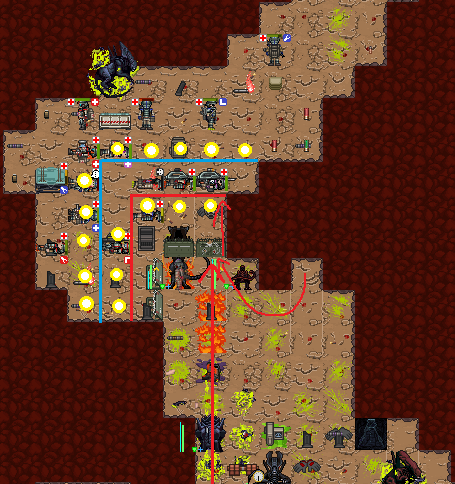
|
The original barricade line makes a small chokepoint which can't effectively utilise the full power of the marines in the area; to fix this the barricade defence could've been constructed on the red line to allow for additional marines to fire or even further back on the blue line to use the xenos cover against them and create a two tile chokepoint that will expose them to more gunfire, while also keeping the defending marines at a safe distance.
✔ Forces the enemy to walk past a choke, Exposing them to more fire on their attempted exit ✔ Two tiles from the enemies nearest position with cover. (Meaning they have to expose themselves to push) ✔ Marines standing one tile behind the barricaded position so they can't be slashed but can still hold the barricade itself. |

|
This is an example of what not to do when constructing a barricade position.
By having the barricades extend outwards it places the defending marines into the chokepoint giving them a disadvantage during combat. |
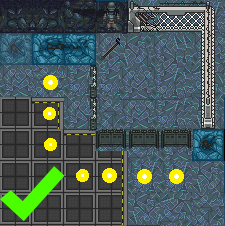
|
This is an example of what you should do when constructing a barricade position.
By having the barricades extend inwards it utilises the chokepoint making it harder for the xenos to push through. |
Frontline FOB/Outpost
A secured space slightly behind the front for marines to resupply, triage and casevac. Without a frontline FOB, Medics and the wounded will be harassed constantly and supply melted. And in the event of counterattack, marines will likely to be routed without a place to fall back to. Frontline FOB doesn't need to be big (a 6x6 space will do, bigger if high pop), otherwise, parts of the FOB likely be left unguarded and be melted.
Secured barricade line
Build at a choke point, apply the principles, and you get a decent defensive position. To reinforce a barricade line, build barricades one tile in front of the barricade line not behind.
Unsecured barricades
Mostly seen when you want to build a secured barricade line but ran out of plasteel, so you have to leave some gaps. While they are not fully secured, they are still useful to hinder counter attacks and block off Boiler gas and Crusher charge. To avoid hindering marines' push, you can build them in the middle of the corridor (e.g. middle 2 tiles out of 4 tiles), then the sides tiles in further one tile.
Barricade as marines push
Sandbags are particularly well suited for this job, as they can be built by marines and the build time is short. Metal barricades (with barbed wire) work too, though instead of standing in the front and build there, it's much safer to build it just behind the front then move them to the front (See this table for how to move barricades).
Robotic limbs repairing
Target the damaged limb and use:
FOB Duty
As an Engineer on FOB duty, you'll be setting up the base that the marines will primarily use to organize, resupply, to retreat to, and to make a final last stand. To make a good FOB, you'll want to make strategic use of your landmines, the smartgun HMG or the sentry gun, and various defensive emplacements. A good FOB is a difference between losing the round and holding off long enough to make a push back and finally win the round.
The Construction page will have everything you need to construct a FOB, from wooden barricades to plasteel barricades. It also includes many other helpful things for an engineer to build around the FOB, or elsewhere.
Principles
You don't always need a mega FOB
LZ/FOB will only see poking most of the round until siege happens because FOB is a hard target. Thus, ambush xenos are likely to focus on marine's unsecured sections of the supply route. Focusing your effort solely on FOB means using a large amount of material to counter a token force while ignoring the threat targeting the more vulnerable areas. Instead, you need to secure flanks/supply route.
Barricade where enemy can't bypass
While Xeno will try to flank you, your job is to make them a hard time to do so. If you build barricades in where they don't matter (not part of the supply route/no marine will be there), you will do Xeno a favour as there will be fewer defences in where that do matter.
It is the weakest point that matters
It doesn't matter there are three layers of barricades in Nexus if the one layer metal barricades at LZ is breached, the wounded and the supply will be killed and melted. Even worse, Xeno can ignore Nexus entirely and focus on LZ then everything in Nexus will be wasted.
Use materials wisely
Plasteel is expensive, 40 points for 30 plasteel (6 doors) vs. 20 points for 50 metal (8 barricades with barbed wire). Yet plasteel is crucial to how many secure spaces you can create. If you are out of plasteel, you are forced to keep an opening in the cade line, thus compromising the effect of the barricade line.
A corridor with traffic? A plasteel barricade with barbed wire. No traffic but a high threat (e.g., Crusher charge/constant poking)? Sandbags barricades with barbed wire. No traffic and want to keep Runners out? Metal barricades with barbed wire. And try to save materials by
 Use blowtorch on the vents/doors. (
Use blowtorch on the vents/doors. ( Flip down before you start.)
Flip down before you start.) Use wrench to move vendors/cabinets/hydro trays as blockades (hydro trays don't block Runner).
Use wrench to move vendors/cabinets/hydro trays as blockades (hydro trays don't block Runner).- Then build barricades behind them if it's high threat and if you can spare the supplies.
FOB Construction Quick Tips
Barricade Placement
| Barricade Placement | Description |
|---|---|
|
This is an example of what not to do when constructing a defensive position. In the picture on the left, you'll see that the aliens can hit the barricade without being shot due to its forward position and as such the alien will be able to break through and kill that marine with ease. | |
|
This is an example of what you should do when constructing a defensive position. To rectify the above barricade placement errors you'll want to move the barricades back one tile like the photo on the left. By moving the barricades back this will allow you to shoot aliens who are attacking them. |
Barbed Wire
![]() Barbed wire is a string of sharp metal that will harm and prevent xenos from pouncing over barricades once attached. It also gives a small health boost to the barricade itself.
Barbed wire is a string of sharp metal that will harm and prevent xenos from pouncing over barricades once attached. It also gives a small health boost to the barricade itself.
| Barbed Wire Tactics | Description |
|---|---|
| In the picture you'll see that the engineer was killed due to the alien being able to pounce over the barricade. | |
|
Due to the engineer placing barbed wire onto the barricades the alien was unable to jump over. |
FOB Space
| How To: Fob Space | Description |
|---|---|
|
This is an example of what not to do when constructing a defensive position. In the picture you'll see that the FOB has very little space for the marines to move around in which will lead to:
| |
|
This is an example of what you should do when constructing a defensive position. In the picture you'll see that the FOB has ample space to move which means:
|
Fixing Breaches in Defences
| Fixing Defensive Breaches | Description |
|---|---|
|
This is an example of what not to do when attempting to fix a breach in the defensive line with hostiles nearby. In the picture you'll see that this is a highly dangerous and ineffective way to fix the breach in a defensive line if hostiles are nearby. This will let you get slashed up by an alien running up willy nilly and will give you less time to react if multiple Aliens decide to push the defensive line. | |
|
This is an example of what to do when attempting to fix a breach in the defensive line with hostiles nearby. In the picture you'll see that it shows the optimal way of repairing a breach in your defenses if Aliens are nearby.
|
Misc. FOB tips
| Fob Tips | Description |
|---|---|
|
In the picture you'll see that it demonstrates that windows, even if reinforced, are not an acceptable replacement for a line of all-American steel barricades.
In summary, avoid using them as a defence. | |
| If you have a secured barricade line and you want to strengthen it, put the extra barricades in front of the secured barricade line not behind, and don't block the plasteel barricades. And if you can make a secured cade line, make one, checkerboard barricades do nothing to hinder the aliens' attack. | |
|
Barricades will end up damaged due to the ravages of war and incompetence, and if it isn't heavily damaged, you'll be able to use a blowtorch on it to repair it. This works on metal and plasteel barricades. Note that if a barricade is too damaged, you will be unable to fix it.
| |
|
Align the plasteel barricades to reduce traffic jam. | |
| Place the plasteel barricade at the side reduce the chance retreating marines blocking defensive fire. It also avoids two marines getting in the way of each other when both are exiting/entering. | |
|
Maze-like barricades serve no purpose as Xeno will not follow the corridor, they will slash them down with no regard yet marines will surfer traffic jam. Instead, align the exit with plasteel. |
Fortifications of the Trade
| Fortification | Material | Function |
|---|---|---|
 Hand Rail |
2 Metal 
|
A handrail to ward off any intrusions into unwanted areas. Provides very little cover without reinforcing it. To reinforce the handrail, simply add 1 metal sheet to it and weld it.
To remove reinforced plate : |
 Snow Barricade |
3 Snow Piles
|
A very weak barricade constructed from snow piles with a snow shovel. It's better than thin air at least.
Deconstruct: |
 Wood Barricade |
10 Wooden Planks 
|
Used for a hasty defense against aliens. Mostly seen prespawned. Can be repaired with additional wooden planks at any damaged condition.
Deconstruct: Bash the wooden barricade to break it. Give back 3 wooden planks |
 Metal Barricade |
5 Metal
|
The most common among the three main types of barricades (20 points for 50 sheets). Can be repaired with a blowtorch if not overtly damaged.
To unsecure: To upgrade a barricade, click on one with 2 metal sheets, a window will prompt open in which you select the upgrade. |
 Metal Barricade Reinforced |
2 Metal
|
An upgraded version of the metal barricade. This one can take much more damage from bullets and slashes but is weak to acids and corrosive materials. Can be repaired with a blowtorch if not overtly damaged. |
 Metal Barricade Bio-hazard Resistant |
2 Metal
|
An upgraded version of the metal barricade. This one can take much more damage from acids and fire but is weak to brute damage dealing weapons. Can be repaired with a blowtorch if not overtly damaged. |
 Metal Barricade Explosion Resistant |
2 Metal
|
An upgraded version of the metal barricade. This one can take much more damage from explosive sources with no downside. Can be repaired with a blowtorch if not overtly damaged. |
 Sandbags |
5 Sandbags
|
Dig up dirt with an entrenching tool to fill up the empty sandbags. A fast fortification to field and can built by any marines. You can construct a sandbag barricade with any amount (maximum of 5) from a stack. The more you have in a stack, the stronger it becomes but if you deploy a sandbag with less than the maximum, the weaker the sandbag's maximum health will be. More sandbags can be added to a weaker one until it reaches full strength. Relatively cheap (20 points for 50 empty sandbags). Can be repaired by using filled sandbags.
Deconstruct: |
 Plasteel Barricade |
10 Plasteel
|
Functions as a gate. The most durable fortification with longest build time. The most expensive barricade (40 points for 30 sheets). Can be repaired with a blowtorch if not overtly damaged. |
 Barbed Wire |
2 Metal
|
Can be added to barricades prevent them from being pounced and climbed over. Damages mobs that melee attack without a weapon. Deconstruct: |
 Wall |
12 Metal 
|
Used to fully block off an area. See Guide to construction for how to construct and deconstruct. |
Your Skillset
To find out about how the skill system works head over to the skills system page.
Guides
- On FOB Duty by RNGPriest on 07 Nov 2019
- The Field Engineer Commandments by Surrealistik on 01 Oct 2017, updated 07 Aug 2018
- [WIP] Useful FOB engineering 101 by Challenger on 22 Jul 2017
- A couple tactically sensible 'cade layout tips by FreeStylaLT on 25 Feb 2018






















































